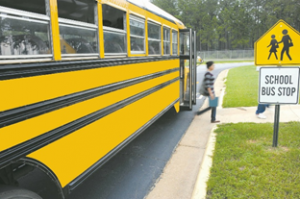 Now that school is in full swing across the nation, truck drivers need to adjust to the increased traffic and congestion on the roads. In addition, they also need to remain vigilant and keep an eye out for school buses, teenage drivers, and children walking to and from school. The following are several suggestions for truck drivers to plan and prepare for driving on roads with new challenges.
Now that school is in full swing across the nation, truck drivers need to adjust to the increased traffic and congestion on the roads. In addition, they also need to remain vigilant and keep an eye out for school buses, teenage drivers, and children walking to and from school. The following are several suggestions for truck drivers to plan and prepare for driving on roads with new challenges.
- Allow more time to complete familiar routes. The paths drivers trekked often over the summer will likely take much longer now that school is back in session. School buses transporting students, parents driving their children to school, teachers returning to the classroom after summer break, and teenagers driving themselves for the first time will all affect traffic patterns and congestion. Compounding the problem is college students starting the fall semester as well as they may be unfamiliar with local routes and cause further delays. Incorporating more time into routes until drivers can learn the new normal for familiar roads can keep frustrations to a minimum and allow drivers to focus on driving safely.
- Reduce speed in school zones. Most cities flank school zones with flashing lights around their speed limit signs to indicate drivers need to slow down. While reducing driving speed in school zones is often the law, there are additional reasons to slow down and increase vigilance in these areas. Many students walk to school and don’t always obey crosswalk signs. Students may cross streets at random so drivers need to remain aware of any walking students on their route. Teenage drivers are also more prone to making driving mistakes or they may not understand who has the right of way so truck drivers should pay extra attention to the vehicles around them in school zones.
- Be aware of school buses. Truck drivers know more school buses means more traffic, but drivers won’t just encounter school buses in school zones. School buses traverse city streets, back roads, rural roads, suburban neighborhoods, and even high ways. This means a truck driver can come across school buses at any point on their route and should plan accordingly. For example, school buses have stricter laws than other drivers, such as right turns on red. It is also illegal to pass a stopped school bus loading or unloading children unless the driver is on the other side of a divided road. Remaining aware of the rules and regulations that govern buses can help keep truck drivers safe and compliant.
Improving drivers’ safety and ensuring their wellbeing while on the road are some of the top concerns for fleet managers. However, it’s not always easy to identify how to go about achieving these objectives. Investing in telematics solutions can help fleets monitor and improve drivers’ performance by collecting data about their driving habits. To learn more about how telematics can improve your fleet’s safety, contact the experts at DriverCheck.